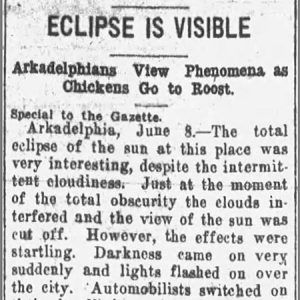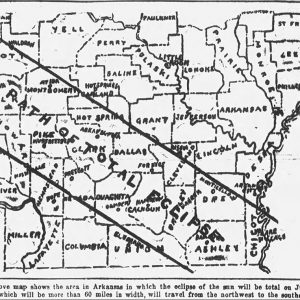calsfoundation@cals.org
Solar Eclipse of 1918
The second of two recorded total solar eclipses—in which the moon totally obscures the sun, leaving only the corona visible—that could be seen in Arkansas occurred on June 8, 1918. While the first, in 1834, was clearly observed as a “magnificent phenomenon of nature in all its sublimity,” the 1918 event was reported as “somewhat of a disappointment.”
On January 3, 1918, the Arkansas Gazette announced that June 8, 1918, would be “a gala day for astronomers,” as a total solar eclipse would cross the United States, beginning in northern Oregon and traveling to northern Florida “at a speed of something like 1,000 miles an hour.” The Hot Springs New Era noted a few weeks later that Mount Ida (Montgomery County) and Arkadelphia (Clark County) would be in the direct path of the totality, and “it is very probable that scientific men from all over the country will visit this city or vicinity to view the eclipse.”
In February, G. L. Harrell of Millsaps College in Mississippi offered a more detailed prediction, holding that the fifty-five-mile-wide northern belt of the eclipse would traverse Rison (Cleveland County), Leola (Grant County), Hempwallace (Garland County), and Waldron (Scott County), while the southern edge would go through Venice (Ashley County), Kirkland (Ouachita County), Emmett (Nevada and Hempstead counties), Nashville (Howard County), and Gillham (Sevier County). The celestial event was expected to begin at 5:31 p.m. and end at 7:34 p.m., with the totality running from 6:35 to 6:36 p.m.
Local educational institutions prepared for the eclipse, with the astronomy department of Henderson-Brown College (now Henderson State University) in Arkadelphia planning to “make observations,” while neighboring Ouachita Baptist College (now Ouachita Baptist University) offered use of the tower at its administration building “to scientists of the Lick Observatory.” The Gazette noted that scientists would photograph the sky near the sun “in search of any stray comet and also the mythical planet Vulcan,” whose “orbit is so close to the sun that it can be seen only during an eclipse,” though its existence “is doubted by most astronomers.” Boosters in Hot Springs (Garland County), which would host the National Editorial Association conference when the eclipse occurred, built a platform for the visiting journalists and stated that “none without badges will be admitted to the enclosure, as the eclipse is especially for the visiting scribes and not for the common people.”
As the day of the eclipse grew closer, Dr. J. Morrison of Mineral Wells, Texas, wrote an article for Arkadelphia’s Southern Standard “for the information of our friends in Arkansas” in which he said the eclipse would enter the state near Mena (Polk County) before being seen in Arkadelphia, Princeton (Dallas County), Fordyce (Dallas County), Warren (Bradley County), Monticello (Drew County), Montrose (Ashley County), and Eudora (Chicot County). In Little Rock (Pulaski County), the Gazette predicted, the eclipse would be “almost total, all but two per cent of the disc, or a slender portion of the rim of the sun, remaining visible during the period of totality.”
On June 8, the Gazette warned that being in the area of the total eclipse “will put one on the verge of a creepy feeling, even in this enlightened time” and said the celestial event “can be viewed through an ordinary piece of glass smoked with a match, but an overexposed (or dark) piece of photographic film is much better.” Presciently, the newspaper noted that “if a big cloud happens to be in the way, the chance of several life times will have to be passed on to the next generation, for an eclipse adheres strictly to its schedule in spite of the elements.”
As the time for the eclipse approached, the Arkansas Democrat reported that local weather expert H. S. Cole said the “hazy condition of the sky during the day was disappointing.” As the event began, the sky was “rainy, and a heavy bank of clouds obscuring the sun during the entire time scheduled for the partial eclipse.” The Gazette would dourly note “all that we saw in Little Rock was the eclipse of the eclipse.”
As the eclipse approached in Camden (Ouachita County), “the clouds began to thicken and except for momentary glimpses the sun was obscured until the event was over,” and for local people “the only phenomenon which they really observed was the passage of the totality shadow on the clouds.” In Hermitage (Bradley County), “those not aware of the phenomena were considerably frightened, some running out of their houses into the streets calling on the Lord for mercy,” while “the chickens went to roost and when the sun popped out again they seem to be very much confused.”
A Gazette correspondent from Arkadelphia noted “intermittent cloudiness,” but found the eclipse’s “effects startling,” writing that “darkness came on very suddenly and lights flashed on over the city[,]…lightning bugs roused from the grass,” and “an old hen, with her little chickens, beat a quick retreat to the coop, [as]…for all appearances it was night.” The Southern Standard observed that “a heavy cloud…obscured the sun just before the time for the totality,” and “at the time for the total eclipse it became as dark as night here for a little over one minute.” The newspaper concluded, though, that the eclipse was “somewhat of a disappointment.”
The first reported total solar eclipse visible over Arkansas occurred on November 30, 1834. Another took place on April 8, 2024.
For additional information:
“Arkansas May Get Fine View of Solar Eclipse.” Arkansas Gazette, April 18, 1918, p. 6.
“Clouds Obscure Total Eclipse.” Southern Standard, June 13, 1918, p. 1.
“Clouds Obstruct View of Eclipse.” Arkansas Gazette, June 9, 1918, p. 24.
“Coming Eclipse Arousing Interest of Scientists.” Arkansas Gazette, June 3, 1918, p. 6.
“Eclipse Here Today an Event of Several Life Times.” Arkansas Gazette, June 8, 1918, p. 6.
“Eclipse Is Obscured.” Arkansas Gazette, June 9, 1918, p. 24.
“Eclipse Is Visible.” Arkansas Gazette, June 9, 1918, p. 24.
“Eclipse of Sun Is Postponed an Hour.” Arkansas Gazette, Part III, May 19,1918, p. 1.
“The Eclipse of the Sun.” Arkansas Gazette, December 2, 1834, p. 3.
“Haze May Prevent View of Eclipse of Sun Here.” Arkansas Democrat, June 8, 1918, p. 1.
“Hermitage Folks Thought World Was at End.” Arkansas Gazette, June 11, 1918, p. 2.
“Little Talks on Astronomy.” Arkansas Gazette, January 3, 1918, p. 4.
“To Observe Eclipse.” Arkansas Democrat, May 8, 1918, p. 2.
“Total Eclipse of Sun June 8.” Mena Weekly Star, February 21, 1918, p. 3.
“Total Eclipse of Sun This Year; Hot Springs in Path of Totality.” Hot Springs New Era, January 23, 1918, p. 4.
“A Total Eclipse of the Sun at Arkadelphia.” Southern Standard, May 30, 1918, p. 5.
“The Very Last Word in Southern Hospitality.” Arkansas Gazette, April 15, 1918, p. 4.
Mark K. Christ
Central Arkansas Library System








Comments
No comments on this entry yet.